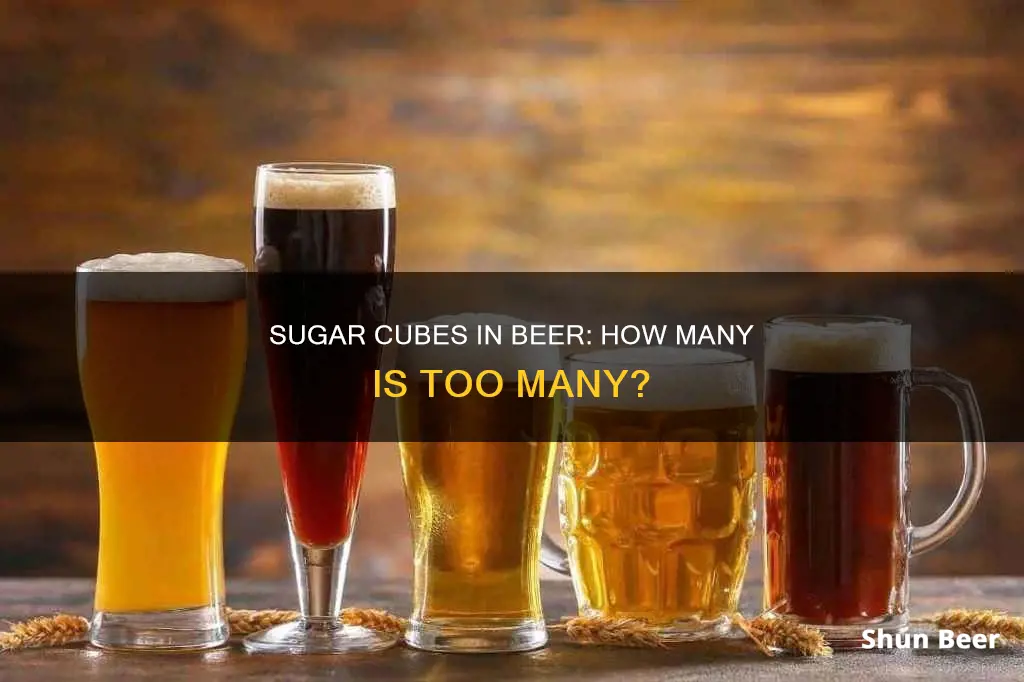
Beer is a popular alcoholic beverage made from grains, spices, yeast, and water. Although sugar is not typically listed as an ingredient, it is created naturally during the fermentation process when grains are processed and fermented by yeast. The amount of sugar in beer depends on several factors, including the type of beer, the ingredients used, and the brewing process. So, how many cubes of sugar does beer contain? Let's find out!
What You'll Learn

Beer's sugar content is derived from the fermentation process
The sugar content of beer is derived from the fermentation process, which involves the following steps:
Malting
This step involves the controlled germination of grains, typically barley and wheat. During germination, the starch in the grains breaks down into fermentable sugars, mainly maltose. Maltose is a disaccharide, meaning it is made up of two glucose molecules, and it is the primary sugar found in beer.
Mashing
In the mashing step, the germinated grains are roasted, milled, and soaked in hot water. This process extracts the sugars from the grains, creating a sugar-containing liquid called wort. The wort's sugar concentration, or gravity, can vary depending on the amount of sugar present. A wort with a high sugar concentration is called a high-gravity wort.
Boiling
During boiling, hops or other spices are added to the wort, which is then cooled and filtered to remove plant residue.
Fermentation
Yeast is added to the wort to begin the fermentation process. The yeast ferments the sugars in the wort, converting them into alcohol and carbon dioxide. The fermentation process decreases the sugar content of the wort while increasing its alcohol content.
Maturation
The final step of brewing is maturation, where the beer is stored and aged.
The sugar content of beer depends on several factors, including the initial gravity of the wort, the type of yeast used, and any additional flavourings such as honey or corn syrup. The yeast used for fermentation plays a significant role in the final sugar content, as different yeast strains have varying alcohol tolerances. Ale yeasts, for example, have a higher alcohol tolerance than lager yeasts and can survive in higher alcohol environments, resulting in ales with lower sugar content.
While beer manufacturers are not required by law to disclose the sugar content on their labels, it is important to note that non-alcoholic beers tend to have higher sugar content, as none of the wort's sugar is converted into alcohol. Light beers may also have slightly higher sugar content due to the addition of glucoamylase, an enzyme that breaks down residual carbs into fermentable sugars, resulting in lower alcohol and calorie content.
Beer vs Jack: Which Drink Has More Sugar?
You may want to see also

Beer contains varying amounts of sugar
Once yeast is introduced, it begins to feed on the sugars, and the sugar content decreases while the alcohol content increases. After fermentation, beer typically comprises 80% fermentable sugars and 20% oligosaccharides, a type of carbohydrate that the yeast and human body cannot digest. Therefore, the final sugar content of a beer depends on several factors, including its gravity, the type of yeast used, and any additional flavours included, such as honey or corn syrup.
The amount of sugar in beer also depends on the style and brewing method. For example, light beers generally have less sugar and fewer calories than traditional beers due to their reduced carbohydrate content. Non-alcoholic beers, on the other hand, tend to have higher sugar content as the sugars are not converted into alcohol. Additionally, different types of beer, such as lagers and pilsners, tend to contain less sugar, while heavier, maltier beers like stouts might have higher sugar levels.
It is important to note that labelling regulations for alcoholic beverages in the United States do not require manufacturers to report the sugar content of their products. Therefore, it can be challenging to determine the exact amount of sugar in a beer. However, according to Healthline, a 12-ounce (355 ml) serving of regular beer typically contains 12.8 grams of carbohydrates and no sugar, while a light beer contains 5.9 grams of carbohydrates and 0.3 grams of sugar.
Calculating Beer Sugar Content for Weight Watchers
You may want to see also

Beer is generally made up of yeast, grains, spices, and water
The process of making beer is known as brewing. A dedicated building for the making of beer is called a brewery, though beer can be made at home and has been for much of its history.
The first step in brewing beer is malting, which allows for the controlled germination of the grain. This is a key step, as germination helps break down stored starch into fermentable sugar – mainly maltose. The grain used is usually barley, although wheat, maize (corn), rice, and oats are also used.
The second step is mashing, which involves roasting, milling, and soaking the germinated grains in hot water. The result is a sugar-containing liquid called wort.
The third step is boiling. During this step, hops or other spices are added. The wort is then briefly cooled and filtrated to eliminate plant residue and debris.
The fourth step is fermentation, where yeast is added to the wort to ferment it, converting sugars into alcohol and carbon dioxide.
The final step is maturation, where the beer is stored and left to age.
While your favourite brew might contain additional ingredients, these are the basic components of beer.
Beer vs. Whiskey: Sugar Content Face-off
You may want to see also

Beer gravity influences the sweetness and alcohol content of beer
Beer gravity, or specific gravity, is a measure of the density of beer or wort (the liquid extracted during the mashing process) compared to the density of water. This density is influenced by the mass of sugar dissolved in the liquid, which is crucial in determining the beer's alcohol content and sweetness.
The original gravity (OG) is a measure of the density of the wort before fermentation, indicating the number of dissolved sugars that can be converted into alcohol. A high original gravity reading, such as 1.100, suggests a potential alcohol percentage of around 10%. Beers with lower original gravity readings, closer to 1, will have a lower alcoholic content.
During fermentation, yeast consumes the sugars in the wort, converting them into alcohol and carbon dioxide. This process decreases the sugar content and increases the alcohol content, resulting in a lower gravity reading. The final gravity (FG) is taken after fermentation and, when compared to the OG, allows brewers to calculate the exact alcoholic strength (ABV) of the beer.
The difference between the OG and FG readings is essential in determining the amount of sugar converted into alcohol. A beer with a high original gravity requires a yeast with sufficient attenuative power to finish the fermentation process. If the yeast lacks this power, too much sugar will remain in the beer, resulting in a higher final gravity than desired.
The type of yeast and additional flavourings, such as honey or corn syrup, also influence the final sugar content of the beer. While most beers have a low sugar content, non-alcoholic beers tend to have a very high sugar content.
Beer and Sugar: What's the Connection?
You may want to see also

Beer contains carbohydrates that can affect blood sugar levels
Beer is generally made from yeast, grains, spices, and water. Although sugar is not added as an ingredient, it is created naturally when the grains are processed and fermented by yeast. The amount of sugar in beer depends on several factors, including its gravity, the type of yeast used, and any additional flavours included, such as honey or corn syrup.
Beer's sugar content primarily comes from the fermentation process, where yeast converts fermentable sugars into alcohol and carbon dioxide. The remaining residual sugars contribute to the beer's taste and body. Beer gravity, which measures the density of the wort before and after fermentation, is crucial in understanding the beer's sweetness and alcohol content. High-gravity beers tend to have more residual sugars and stronger flavours, while low-gravity beers have lower alcohol content and are less sweet.
While beer typically has a low sugar content, it contains carbohydrates that can affect blood sugar levels. Alcohol impairs sugar metabolism, inhibiting the body's production and breakdown of stored sugar, which is necessary to maintain blood sugar balance. As a result, beer consumption may lead to hypoglycaemia or low blood sugar levels. It is generally recommended to consume beer with a carbohydrate-containing meal to avoid negative health effects.
The sugar content in beer varies depending on the type and brand. Regular beers usually contain moderate amounts of fermentable sugars, which are converted into alcohol during brewing. Light beers are crafted to be lower in calories and carbohydrates, so they have less sugar and a lighter body. Non-alcoholic beers, on the other hand, can sometimes have higher sugar levels than alcoholic versions since the sugars are not converted into alcohol. However, modern non-alcoholic beers often have reduced sugar content.
In summary, while beer may not have high sugar levels, it contains carbohydrates that can impact blood sugar levels. Alcohol's interference with sugar metabolism can lead to low blood sugar or hypoglycaemia. Therefore, it is important to monitor beer consumption, especially for those concerned about blood sugar management or diabetes.
Beer's Sweet Secret: Sugar Content Explored
You may want to see also
Frequently asked questions
The amount of sugar in beer varies depending on the type and brand of beer. Generally, beer has less sugar than other alcoholic drinks like wine. However, some beers can have a higher sugar content due to added ingredients, such as honey or corn syrup.
Regular beer typically contains around 12.8 grams of carbohydrates and 0 grams of sugar.
Light beer usually contains approximately 5.9 grams of carbohydrates and 0.3 grams of sugar.
Non-alcoholic beer often has higher sugar levels than alcoholic beers. It typically contains about 28.5 grams of carbohydrates and 28.5 grams of sugar.







